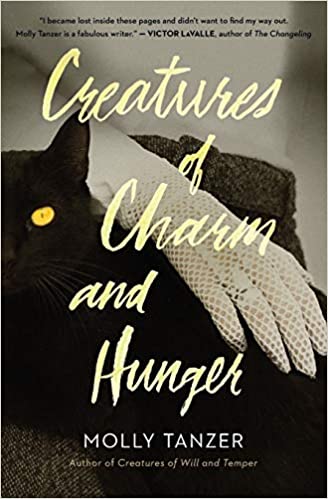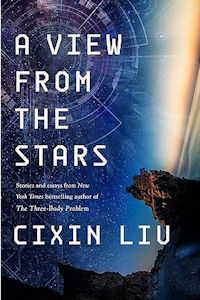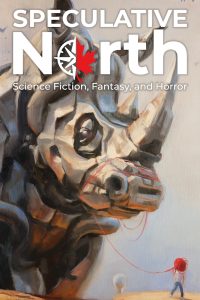Gary K. Wolfe Reviews Creatures of Charm and Hunger by Molly Tanzer
 Creatures of Charm and Hunger, Molly Tanzer (John Joseph Adams 978-0-358-06521-0, $16.99, 320pp, tp) April 2020.
Creatures of Charm and Hunger, Molly Tanzer (John Joseph Adams 978-0-358-06521-0, $16.99, 320pp, tp) April 2020.
When Molly Tanzer introduced her ”Diabolist’s Library” trilogy with Creatures of Will and Temper back in 2017, she combined the sharply insightful coming-of-age tale of two contrasting sisters finding their way in Victorian London with a cleverly gender-swapped version of Wilde’s The Picture of Dorian Gray. Then, with a skillful narrative sleight-of-hand, she shifted the whole tale into a rousing supernatural adventure involving rival diabolists summoning demons who sometimes seemed to function as addictive drugs. Throughout, she alluded to a fictional handbook called On the Summoning of Demons – sort of her world’s Necronomicon – from which we learn that demons are ”creatures of will and temper, of want and ruin, of charm and hunger, of pique and cunning.” Not surprising, then, that her second volume would be titled Creatures of Want and Ruin and this concluding volume Creatures of Charm and Hunger (unless, of course, there are some critters of pique and cunning waiting in the wings). The second novel abandoned the specific literary template that the Wilde novel had provided for Creatures of Will and Temper, moving the setting from Victorian England to jazz-age Long Island, but those lavish Long Island parties inevitably lent the novel a Gatsbyesque vibe. The third volume shifts time and place again, this time depositing us in the fairly remote English village of Hawkshead in the waning days of WWII. The main shift, though, involves point of view: while the first two novels featured innocently mundane characters gradually discovering the demon-haunted world of the diabolists, this one begins with young diabolists learning their craft – and learning to confront some of the mundane world’s own horrors.
The Cumbrian farmhouse which is the principle setting is more than its outward appearance would suggest: it houses the main research library of the Société des Éclairées, the century-old international organization of scientific diabolists which is now assisting the allies in their fight against the Nazis’ own brand of diabolists, and the librarian in charge is Nancy Blackwood. Nancy’s sister Edith is also a member of the Société, but the real focus of the novel is on the relationship between the two teenage girls living with Nancy: her rebellious daughter Jane and her half-Jewish ward Miriam Cantor, who is Jane’s best friend and whose own parents have gone missing in their work in the resistance and are suspected of having turned traitor. When Edith arrives from Paris to supervise the rather odd test that will supposedly determine the girls’ future as diabolists, each of the girls is motivated to strike out on her own project – Miriam to find out what really happened to her parents, and Jane, who thinks she failed the test, to track down the father that Nancy has refused to tell her anything about. Meanwhile, Nancy seems strangely distracted, allowing her own work as librarian to pile up while she seems oblivious to the dangers the girls are leading themselves into.
Supernatural WWII novels, in which Allied and Nazi demons or wizards or superheroes conduct their own behind-the-scenes battles, are hardly news anymore, as novels by Ian Tregillis, David Mack, Kay Kenyon, Lavie Tidhar and others have demonstrated. For the most part, Tanzer avoids the temptation of turning her essentially personal family tale into a high-stakes pseudohistorical spectacle, although she can’t quite resist giving us yet another version of a diabolical Mengele figure, with whom Miriam grapples after learning that she can temporarily inhabit the bodies of others (including even a wasp, in the novel’s most unlikely set piece), though the skill comes at great cost to herself. Jane, for her part, not only decides to go full witch-mode by enchanting a broom, but takes an unknown risk by inviting a demon to inhabit her beloved cat Smudge. As in Creatures of Will and Temper, the core of the novel lies in the relationship between these two young women and their contrasting efforts to reclaim their heritage, but here their choices seem more ambiguous and even morally dubious, involving not only the risk of dangerously misusing the arcane knowledge hidden in the diabolists’ library, but of comparatively petty betrayals such as spying on each other’s efforts and meddling in each other’s relationships. Creatures of Charm and Hunger, with its relatively small cast of characters and constrained settings, takes on a distinctly darker tone than the earlier novels in the series, perhaps because of its relatively muted allusions to the Holocaust, Miriam’s own confrontation with the realities of anti-Semitism in Hawkshead, and the gravity of losing (or almost losing) a parent. But the girls themselves – flawed, impulsive, jealous, at times almost fatally self-absorbed, and yet courageous and well-intentioned – lend the novel a depth of characterization that is perhaps the strongest in the series so far. Managing demons and astral projections may be tricky, but not as tricky as managing your own mistakes. Hope the cat’s OK.
Gary K. Wolfe is Emeritus Professor of Humanities at Roosevelt University and a reviewer for Locus magazine since 1991. His reviews have been collected in Soundings (BSFA Award 2006; Hugo nominee), Bearings (Hugo nominee 2011), and Sightings (2011), and his Evaporating Genres: Essays on Fantastic Literature (Wesleyan) received the Locus Award in 2012. Earlier books include The Known and the Unknown: The Iconography of Science Fiction (Eaton Award, 1981), Harlan Ellison: The Edge of Forever (with Ellen Weil, 2002), and David Lindsay (1982). For the Library of America, he edited American Science Fiction: Nine Classic Novels of the 1950s in 2012, with a similar set for the 1960s forthcoming. He has received the Pilgrim Award from the Science Fiction Research Association, the Distinguished Scholarship Award from the International Association for the Fantastic in the Arts, and a Special World Fantasy Award for criticism. His 24-lecture series How Great Science Fiction Works appeared from The Great Courses in 2016. He has received six Hugo nominations, two for his reviews collections and four for The Coode Street Podcast, which he has co-hosted with Jonathan Strahan for more than 300 episodes. He lives in Chicago.
This review and more like it in the July 2020 issue of Locus.
 While you are here, please take a moment to support Locus with a one-time or recurring donation. We rely on reader donations to keep the magazine and site going, and would like to keep the site paywall free, but WE NEED YOUR FINANCIAL SUPPORT to continue quality coverage of the science fiction and fantasy field.
While you are here, please take a moment to support Locus with a one-time or recurring donation. We rely on reader donations to keep the magazine and site going, and would like to keep the site paywall free, but WE NEED YOUR FINANCIAL SUPPORT to continue quality coverage of the science fiction and fantasy field.







